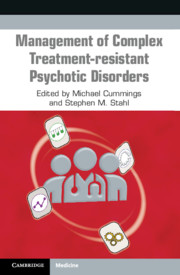Book contents
- Management of Complex Treatment-Resistant Psychotic Disorders
- Management of Complex Treatment-Resistant Psychotic Disorders
- Copyright page
- Contents
- Contributors
- Acknowledgements
- Abbreviations
- List of Icons
- Introduction
- Part I Treatment Strategies
- 1.01 Approaches to Positive Psychotic Symptoms
- 1.02 Use of Plasma Levels in Antipsychotic and Mood Stabilizer Treatment
- 1.03 Advantages of Long-Acting Injectable Antipsychotics
- 1.04 Approach to Treatment-Resistant Schizophrenia Spectrum Patients
- 1.05 Approach to Depressed or Suicidal Schizophrenia Spectrum Patients
- 1.06 Approach to Persistent Aggression and Violence in Schizophrenia Spectrum Psychotic Disorders
- 1.07 Approach to Bipolar Diathesis in Schizophrenia Spectrum Patients
- 1.08 Approach to Anxiety in Schizophrenia Spectrum Patients
- 1.09 Approach to Insomnia and Sleep Disturbance in Schizophrenia Spectrum Disorders
- 1.10 Approach to Psychosis in Children and Adolescents
- 1.11 Electroconvulsive Therapy and Other Non-Pharmacological Treatments
- 1.12 Approach to Substance Use Disorders in Schizophrenia Spectrum Disorders
- 1.13 Approaches to Behavioral Disturbances in Dementia and Traumatic Brain Injury Patients
- Part II Medication Reference Tables
- Appendices
- Index
- References
1.10 - Approach to Psychosis in Children and Adolescents
from Part I - Treatment Strategies
Published online by Cambridge University Press: 19 October 2021
- Management of Complex Treatment-Resistant Psychotic Disorders
- Management of Complex Treatment-Resistant Psychotic Disorders
- Copyright page
- Contents
- Contributors
- Acknowledgements
- Abbreviations
- List of Icons
- Introduction
- Part I Treatment Strategies
- 1.01 Approaches to Positive Psychotic Symptoms
- 1.02 Use of Plasma Levels in Antipsychotic and Mood Stabilizer Treatment
- 1.03 Advantages of Long-Acting Injectable Antipsychotics
- 1.04 Approach to Treatment-Resistant Schizophrenia Spectrum Patients
- 1.05 Approach to Depressed or Suicidal Schizophrenia Spectrum Patients
- 1.06 Approach to Persistent Aggression and Violence in Schizophrenia Spectrum Psychotic Disorders
- 1.07 Approach to Bipolar Diathesis in Schizophrenia Spectrum Patients
- 1.08 Approach to Anxiety in Schizophrenia Spectrum Patients
- 1.09 Approach to Insomnia and Sleep Disturbance in Schizophrenia Spectrum Disorders
- 1.10 Approach to Psychosis in Children and Adolescents
- 1.11 Electroconvulsive Therapy and Other Non-Pharmacological Treatments
- 1.12 Approach to Substance Use Disorders in Schizophrenia Spectrum Disorders
- 1.13 Approaches to Behavioral Disturbances in Dementia and Traumatic Brain Injury Patients
- Part II Medication Reference Tables
- Appendices
- Index
- References
Summary
Psychotic symptoms in children and adolescents are common especially in the context of anxiety and mood disorders. The prevalence is higher in younger children than in adolescents [1]. Assessing, diagnosing and treating young people presenting with psychotic symptoms is challenging. Children have psychotic experiences that may or may not indicate a psychotic spectrum disorder or other psychopathology. In fact, there is evidence that 40–60% of youth with bipolar illness and 15–35% with depression have psychotic symptoms [2]. One must establish a systematic approach when trying to determine the underlying cause of psychosis in children and adolescents. Moreover, it is vital to understand the presentations of schizophrenia that occur in children and adolescents, the psychiatric and medical conditions that have psychotic features, the drugs and medications that can induce a psychotic state, the recommended parameters when assessing and diagnosing youth with psychotic disorders, the recommended parameters when using antipsychotic medications in youth, the effectiveness of different antipsychotics when treating this population, the medications that are currently approved by the U.S. Food and Drug Administration (FDA) for use in children and adolescents and the psychosocial interventions that may ameliorate psychotic symptoms. While no fail-safe approach exists to correctly identify children and adolescents with psychotic disorders, utilizing a systematic structure can increase accuracy, and therefore support development of an appropriate and comprehensive plan of care that will benefit the youth. An African proverb says that it takes a village to raise a child. The same applies when assessing, diagnosing and treating youth with psychosis. It takes collaboration with different disciplines, systems, organizations and working closely with guardians and family members.
- Type
- Chapter
- Information
- Publisher: Cambridge University PressPrint publication year: 2021



